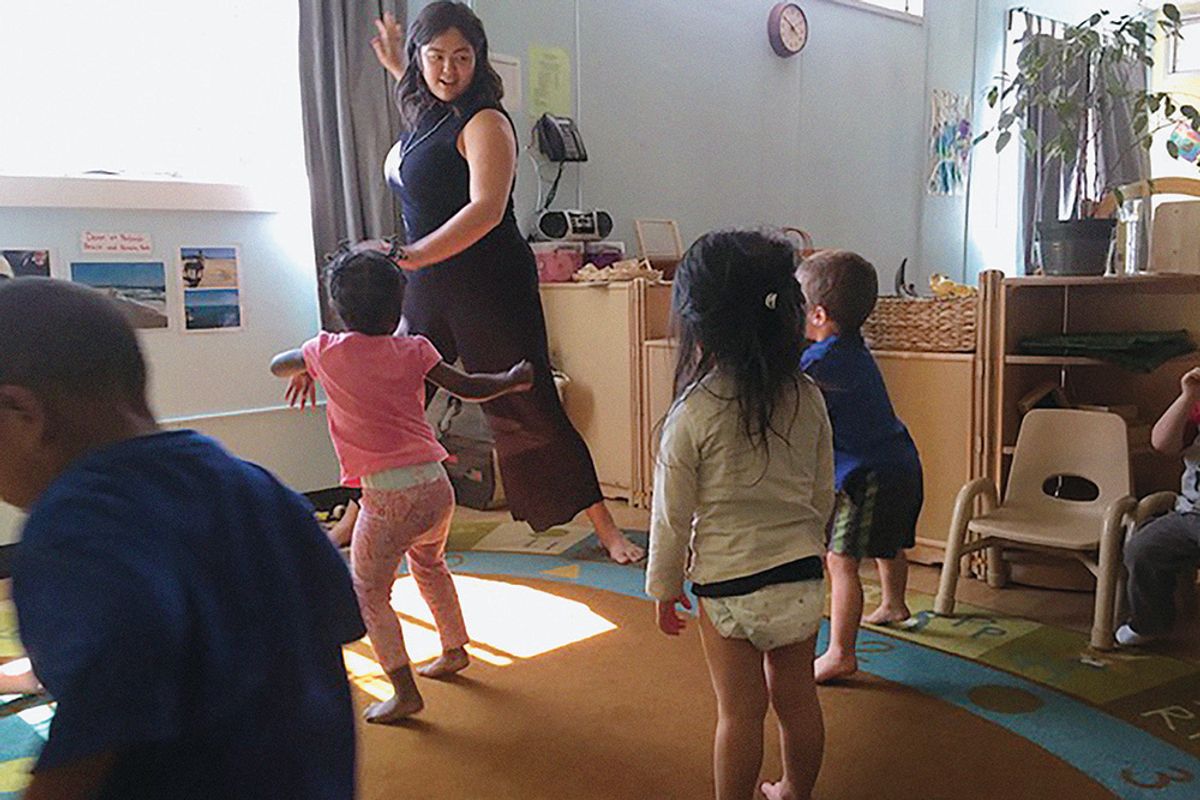
In Aiano Nakagawa’s creative-dance class at Acorn Woodland Child Development Center in Oakland, California, a student wanted to run really fast instead of exploring shapes as planned. Nakagawa didn’t dismiss or correct the desire. Instead, she yelled, “Yeah! And can you try a sharp shape at the end?” Another time, teachers were asking students not to go underneath tables in the room, but students wanted to anyway. So, Nakagawa’s next lesson involved a theme for dancing under things.
Nakagawa teaches ages 0 to 7 at Luna Dance Institute in Berkeley and has founded a publication and platform for QTBIPOC (queer/trans/black/indigenous/people of color) creatives to empower themselves and others through art, called Art for Ourselves. In this work with adults and teens, she says that “it’s really about undoing internalized oppression. But young children have an innate sense of freedom, a deep connection to sensation.” By promoting that autonomy, she believes that we can collectively dismantle oppressive systems from the ground up. For her, teaching dance is not just about students being creative or physically active, but a way of fostering critical thinking and social justice.
Nakagawa’s teaching philosophy centers on children’s power to express and be themselves. Her students’ individual choices are taken seriously and validated. She focuses on “consent and agency,” she says, and urges dance teachers of all ages and styles to “reflect on how you can cultivate a culture of freedom. Ask yourself: ‘What am I socializing these children for? Is it to be able to best copy another person? Or is it to be able to know themselves on a deep, deep level?'”
A good example of how Nakagawa encourages exploration comes in her parent/child classes, where she loves playing with exchanges of power. She will have the child tell a parent three moves to perform, and vice versa, so each feels empowered. And to support critical thinking about power, they’ll discuss: What does it feel like to tell people what to do? To be told what to do? What are ways to do it respectfully, and why?
Another example is at the start of every Luna Dance Institute class: With Anne Green Gilbert’s BrainDance and Bartenieff Fundamentals as a warm-up, Nakagawa wants kids to explore their bodies in any way they see fit. When she leads the tactile part of the warm-up, she tells both parents and students this is a time to check in with their bodies and try different ways of touching them: “Hard squeezes, gentle tickles…and know that the body’s needs change all the time.”
She reminds them that what one person needs is not what someone else needs. The ability to notice and articulate personal bodily requests and boundaries is vital to her teaching work. Her belief that children can and will have this conversation with their bodies is what she might have liked in her own childhood.
Nakagawa created her teaching approach in response to her personal experience with an eating disorder as a teen. She grew up in Portland, Oregon, where she danced 30 hours per week in middle and high school and was accepted into a prestigious high school dance company. But being a tall, big-bodied dancer of color in a predominantly white city and a predominantly white dance form, she never “fit the mold” and was “trying to match a Eurocentric and white American aesthetic. I never felt like I fit in my own body,” she says.
Nakagawa’s artistic director asked her to lose weight, which she did—10 pounds in a single month. At the end of the year, the director told Nakagawa that her trying to be a dancer was like someone unattractive trying to be a model. “It completely broke my heart,” she says. Depressed, she didn’t dance at all her senior year and went to college to study English. It wasn’t until Nakagawa took a dance improvisation class in college that she “felt agency over my body for the first time. I started to heal from the eating disorder,” she says. The discovery came in tandem with courses and conversations about feminism, child development and psychology.
While completing her dance degree, Nakagawa says, she realized: “When we’re very young, there is a time to eat, a time to drink, a time to go to the bathroom. I was so cued out of my own body’s rhythm and natural cues; I’d just learned to silence them. To fit someone else’s schedule.” She wondered, what if she hadn’t been told to “hold your belly in” or “follow my form” in dance class? And she pursued a master’s, she says, to further “understand the root cause, not just the symptoms, of how this perverse ‘power-over’ is able to exist, to truly understand how systems of oppression—that are invisible but completely control our lives—work.”
During California’s shelter-in-place this spring, Nakagawa created prerecorded videos for her students and sent them dance activities, including a dance scavenger hunt for 5- to 7-year-olds. They had to find heavy, light, smooth and rough objects, describe these items with their bodies and make a dance. She also made videos for classroom teachers at Luna to keep dance alive for their students.
Though firm in her mission, Nakagawa is patient with kids. “This is a process of trusting that people know what they need,” she says. “If we could just keep ourselves there, we could change the world.”



